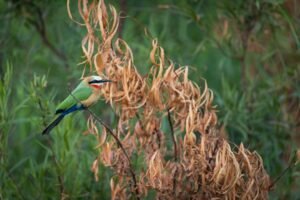The Kakapo (Strigops habroptilus) is a critically endangered parrot species endemic to New Zealand. It is notable for being the world’s only flightless parrot and the heaviest parrot species, with males weighing up to 4 kg and females up to 2 kg. The Kakapo is characterized by its moss-green plumage, owl-like facial features, and nocturnal behavior.
Its name derives from the Maori language, translating to “night parrot.”
Kakapos are known for their distinctive breeding system, which involves a lek mating ritual where males compete for female attention through elaborate displays and booming calls. They have a low reproductive rate, with breeding occurring only every 2-4 years when certain native trees produce abundant fruit. The species has experienced a severe population decline due to habitat loss, introduced predators, and human hunting.
By the 1990s, fewer than 50 individuals remained. Intensive conservation efforts, including predator control, habitat restoration, and captive breeding programs, have since increased the population to over 200 birds as of 2021. Kakapos are now confined to predator-free islands, where they are closely monitored and managed.
Despite progress in conservation, the species remains critically endangered and faces ongoing challenges, including genetic bottlenecks and vulnerability to disease.
Key Takeaways
- The Kakapo is a critically endangered flightless parrot native to New Zealand, known for its unique appearance and behavior.
- The Kakapo population has declined drastically due to habitat loss, introduced predators, and low reproductive rates.
- Unique characteristics of the Kakapo include its nocturnal behavior, ability to climb trees, and its distinctive booming call.
- Conservation efforts, including predator control and captive breeding programs, have led to a slow increase in the Kakapo population.
- Threats to the Kakapo population include disease, inbreeding, and the impacts of climate change, requiring ongoing conservation efforts to ensure their survival.
The History and Decline of the Kakapo Population
The Devastating Impact of Introduced Predators
The arrival of humans and introduced predators such as rats, cats, and stoats has had a devastating impact on the Kakapo population. These predators have decimated the Kakapo’s natural habitat and prey, leading to a rapid decline in their numbers.
Habitat Destruction and Fragmentation
In addition to predation, habitat destruction has also played a significant role in the decline of the Kakapo population. The clearing of forests for agriculture and development has reduced the available habitat for the Kakapo, further exacerbating their vulnerability to predators.
Conservation Efforts and the Road to Recovery
As a result, by the late 20th century, the Kakapo population had plummeted to just a few dozen individuals, making it one of the rarest and most endangered birds in the world. Efforts to save the Kakapo from extinction have been ongoing for decades, with dedicated conservationists working tirelessly to protect and restore their habitat, as well as implementing breeding programs to increase their numbers. Despite these efforts, the road to recovery has been long and challenging, and the Kakapo remains on the brink of extinction.
Unique Characteristics and Behaviors of the Kakapo

The Kakapo is a truly remarkable bird with a number of unique characteristics and behaviors that set it apart from other parrot species. One of its most distinctive features is its large, round body and short wings, which make it flightless. Instead of flying, the Kakapo uses its powerful legs to climb trees and navigate its forest habitat.
Its moss-green plumage provides excellent camouflage among the forest undergrowth, allowing it to blend in seamlessly with its surroundings. In addition to its physical characteristics, the Kakapo is also known for its unusual behaviors. Unlike most parrots, which are diurnal, the Kakapo is nocturnal, meaning it is most active at night.
This nocturnal behavior is thought to have evolved as a defense mechanism against predators, allowing the Kakapo to avoid detection while foraging for food. The Kakapo is also known for its distinctive mating call, which can be heard over long distances in the forest. Males gather in traditional mating arenas called “lek” sites, where they compete for the attention of females by displaying and calling loudly.
Another unique aspect of the Kakapo’s behavior is its friendly and curious nature. Unlike many other bird species, the Kakapo is not afraid of humans and has been known to approach people with curiosity. This friendly demeanor has endeared the Kakapo to many people and has made it a beloved symbol of New Zealand’s natural heritage.
Conservation Efforts and Successes
| Conservation Efforts | Successes |
|---|---|
| Protected Areas | Increased biodiversity |
| Species Reintroduction | Population recovery |
| Community Engagement | Improved habitat protection |
Conservation efforts to save the Kakapo from extinction have been ongoing for several decades, with dedicated conservationists working tirelessly to protect and restore their habitat, as well as implementing breeding programs to increase their numbers. One of the most successful conservation initiatives for the Kakapo has been the establishment of predator-free islands where Kakapo populations can be protected from introduced predators. These islands provide a safe haven for the birds to breed and thrive without the threat of predation.
Breeding programs have also played a crucial role in the conservation of the Kakapo. In 1995, a groundbreaking initiative known as “kakapo recovery” was launched to increase breeding success and genetic diversity among the remaining Kakapo population. This program has involved intensive monitoring of individual birds, as well as artificial insemination and hand-rearing of chicks to increase their chances of survival.
In recent years, these conservation efforts have shown some success, with an increase in the number of breeding females and successful hatching of chicks. The dedication and hard work of conservationists have resulted in a slow but steady increase in the Kakapo population, offering hope for the future of this critically endangered species.
Challenges and Threats to the Kakapo Population
Despite the progress that has been made in conserving the Kakapo population, significant challenges and threats remain that continue to jeopardize their survival. One of the biggest ongoing threats to the Kakapo is predation by introduced predators such as rats, cats, and stoats. These predators pose a constant threat to the remaining Kakapo population, particularly on mainland New Zealand where they are more vulnerable to predation.
Habitat loss and fragmentation also continue to be major threats to the Kakapo population. The clearing of forests for agriculture and development has reduced the available habitat for the Kakapo, making them more susceptible to predation and limiting their ability to find suitable mates and breeding sites. Another significant challenge facing the conservation of the Kakapo is their low reproductive rates.
Female Kakapos only breed every 2-4 years when certain conditions are met, such as an abundance of food resources. This slow reproductive rate makes it difficult for the population to recover quickly from declines and increases their vulnerability to extinction. Climate change is also emerging as a potential threat to the Kakapo population.
Changes in temperature and weather patterns can impact food availability and breeding success, further adding to the challenges facing this critically endangered species.
The Future of the Kakapo Species

Protecting and Restoring Habitat
Continued efforts to safeguard and restore their habitat, as well as ongoing predator control measures, will be vital in ensuring the survival of the Kakapo. The establishment of more predator-free islands and the expansion of existing ones will provide additional safe havens for breeding populations of Kakapos.
Breeding Programs: A Key to Survival
Breeding programs will play a crucial role in securing the future of the Kakapo species. By increasing breeding success and genetic diversity among the remaining population, these programs can help bolster their numbers and reduce their vulnerability to extinction.
Raising Awareness and Support
Public awareness and support will also be essential in securing the future of the Kakapo species. By raising awareness about their plight and garnering support for conservation efforts, we can help ensure that future generations will have the opportunity to experience these remarkable birds in their natural habitat.
How You Can Help Protect the Kakapo
There are several ways that individuals can help protect and support conservation efforts for the Kakapo species. One of the most effective ways to contribute is by supporting organizations that are dedicated to conserving and protecting endangered species like the Kakapo. Donations to these organizations can help fund critical conservation initiatives such as predator control measures, habitat restoration, and breeding programs.
Raising awareness about the plight of the Kakapo is also crucial in garnering support for their conservation. By sharing information about their unique characteristics, behaviors, and conservation status with friends, family, and colleagues, we can help raise public awareness about their plight and inspire others to get involved in conservation efforts. Visiting New Zealand and participating in ecotourism activities can also support conservation efforts for the Kakapo.
Many tour operators offer opportunities to visit predator-free islands where Kakapos are protected, providing an opportunity to see these remarkable birds in their natural habitat while contributing to their conservation through tourism dollars. Finally, taking steps to reduce our own environmental impact can also benefit endangered species like the Kakapo. By reducing our carbon footprint, minimizing waste, and supporting sustainable practices, we can help mitigate some of the threats posed by climate change and habitat loss that impact endangered species around the world.
In conclusion, the future of the Kakapo species depends on our collective efforts to protect and conserve them. By supporting conservation initiatives, raising awareness about their plight, participating in ecotourism activities, and reducing our environmental impact, we can all play a role in securing a brighter future for this critically endangered species. With continued dedication and support, there is hope that future generations will have the opportunity to experience these remarkable birds in their natural habitat for years to come.
If you’re interested in learning more about unique and endangered bird species, you might want to check out this article about the kakapo birds. These fascinating creatures are the focus of conservation efforts due to their dwindling population, and this article provides insight into the challenges they face and the efforts being made to protect them.
FAQs
What is a kakapo bird?
The kakapo, also known as the night parrot, is a large, flightless, nocturnal parrot native to New Zealand. It is critically endangered and is known for its distinctive owl-like appearance and sweet, musty odor.
How many kakapo birds are left in the world?
As of 2021, there are only around 200 kakapo birds left in the world, making them one of the rarest and most endangered species of parrot.
Why are kakapo birds endangered?
Kakapo birds are endangered due to habitat destruction, predation by introduced species such as rats and cats, and low breeding rates. Their inability to fly also makes them vulnerable to predators.
What is being done to save the kakapo bird from extinction?
Conservation efforts for the kakapo include predator control, habitat restoration, captive breeding programs, and intensive monitoring of the remaining population. The New Zealand government and conservation organizations are working together to protect and increase the kakapo population.
What is the diet of a kakapo bird?
Kakapo birds are herbivores and primarily feed on native plants, fruits, seeds, and leaves. They have a specialized diet that includes the leaves of the rimu tree and the fruits of the rimu and kahikatea trees.
How long do kakapo birds live?
Kakapo birds have a long lifespan, with some individuals living up to 90 years in captivity. In the wild, their lifespan is estimated to be around 60 years.




















+ There are no comments
Add yours